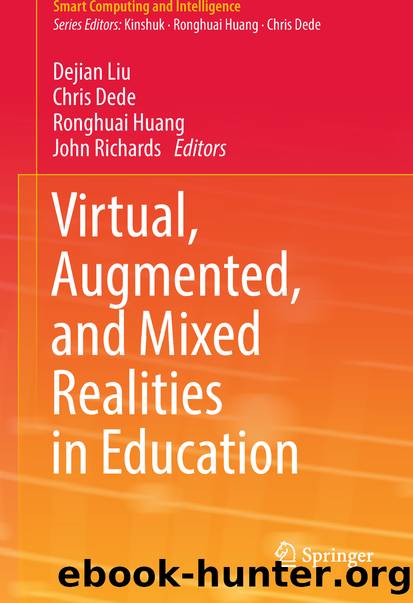Virtual, Augmented, and Mixed Realities in Education by Dejian Liu Chris Dede Ronghuai Huang & John Richards

Author:Dejian Liu, Chris Dede, Ronghuai Huang & John Richards
Language: eng
Format: epub
Publisher: Springer Singapore, Singapore
Keywords
TA
1
Virtual reality
171
2
Interactive learning environment
64
3
Augmented reality
60
3
Simulation
54
4
Education
36
5
Second life
28
6
Virtual worlds
28
7
Laparoscopy
27
8
Teaching/learning strategies
27
9
Medical education
26
10
Immersion
20
Fig. 7.5Network visualization of 30 keywords which meet the threshold of occurrence at least 10 times
7.3 Discussions
7.3.1 Empirical Findings from Previous Studies
Overall, the hypothesis that VR technology promotes learning has been supported by a number of previous studies. For example, in a study about using VR in biology classes on animal cells, researchers found that students had a better understanding about the complexity of the natural world (Minogue, Jones, Broadwell, & Oppewall, 2006). In another study on learning molecular chemistry, VR technology with haptics feedback contributed to the understanding of concepts, and made the learning process more interesting and interactive (Sato, Liu, Murayama, Akahane, & Isshiki, 2008).
The positive effects of VR technology on learning were also found in some studies with 3D models, which were considered to be a normal form for VR technology. Nicholson et al. (2006) conducted an experiment on the effects of computer-generated 3D anatomical models on learning, and found a positive relationship between the computer-generated 3D models they used and the scores of students (Nicholson, Chalk, Funnell, & Daniel, 2006). Similar findings were also indicated by another study in which researchers used Construct3D to help students learn mathematics and geometry, and found that the knowledge presented with Construct3D was easier to learn and facilitated the learning of geometric constructions (Kaufmann, Schmalstieg, & Wagner, 2000).
Some studies based on Second Life, which is a popular VR platform in education, also revealed some positive effect on learning. The virtual campus based on Second Life was found advantageous to improving user impressions concerning presence, awareness, communication, and comfort with the virtual environment (De Lucia, Francese, Passero, & Tortora, 2009). Another study carried out over a year and half observing several groups of students found that the students who learned electronic related subjects through mixed lessons combining traditional on-site lessons with virtual lessons on Second Life platform had higher motivations for learning and attending learning activities (Sierra, Gutiérrez, & Garzón-Castro, 2012).
Some studies on collaborate learning based on VR technology were also proved positive in promoting learning, because students were able to discuss with their classmates, share their findings, and demonstrate the operations of systems to their classmates and teachers (Chen, Yang, Shen, & Jeng, 2007). When it comes to skills training, VR technology also plays an important role. In the training of assembling, VR technology was found to be better than traditional 2D engineering drawing lessons (Boud et al., 1999). One of the main reasons for this was that assembly not only had a requirement for learning sequence, but also for motor behavior. VR participants were able to investigate assembly sequences through a number of VR conditions. However, Boud et al. (1999) also highlighted that one of the main problems of VR technology is the lack of haptic feedback, which plays an important role when manipulating objects. This problem was also found when researchers compared VR technology and AR technology for training laparoscopic skills (Botden, Buzink, Schijven, & Jakimowicz, 2007).
Although many researchers put
Download
This site does not store any files on its server. We only index and link to content provided by other sites. Please contact the content providers to delete copyright contents if any and email us, we'll remove relevant links or contents immediately.
| Administration | Assessment |
| Educational Psychology | Experimental Methods |
| History | Language Experience Approach |
| Philosophy & Social Aspects | Reform & Policy |
| Research |
The Art of Coaching Workbook by Elena Aguilar(48065)
Trainspotting by Irvine Welsh(20055)
Twilight of the Idols With the Antichrist and Ecce Homo by Friedrich Nietzsche(17707)
Fangirl by Rainbow Rowell(7834)
Periodization Training for Sports by Tudor Bompa(7328)
Change Your Questions, Change Your Life by Marilee Adams(6641)
This Is How You Lose Her by Junot Diaz(5773)
Grit by Angela Duckworth(4738)
Red Sparrow by Jason Matthews(4668)
Asking the Right Questions: A Guide to Critical Thinking by M. Neil Browne & Stuart M. Keeley(4576)
Paper Towns by Green John(4169)
Room 212 by Kate Stewart(4107)
Ken Follett - World without end by Ken Follett(3973)
The Sports Rules Book by Human Kinetics(3588)
Housekeeping by Marilynne Robinson(3401)
The Motorcycle Diaries by Ernesto Che Guevara(3333)
Introduction to Kinesiology by Shirl J. Hoffman(3301)
Exercise Technique Manual for Resistance Training by National Strength & Conditioning Association(3292)
Double Down (Diary of a Wimpy Kid Book 11) by Jeff Kinney(3273)
